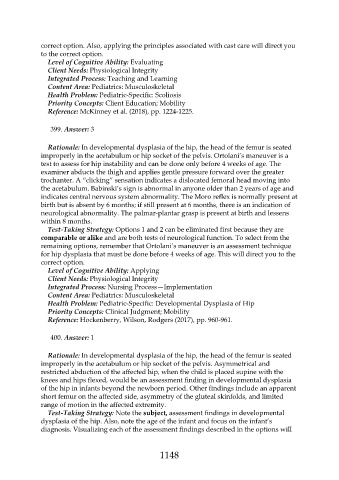Page 1148 - Saunders Comprehensive Review For NCLEX-RN
P. 1148
correct option. Also, applying the principles associated with cast care will direct you
to the correct option.
Level of Cognitive Ability: Evaluating
Client Needs: Physiological Integrity
Integrated Process: Teaching and Learning
Content Area: Pediatrics: Musculoskeletal
Health Problem: Pediatric-Specific: Scoliosis
Priority Concepts: Client Education; Mobility
Reference: McKinney et al. (2018), pp. 1224-1225.
399. Answer: 3
Rationale: In developmental dysplasia of the hip, the head of the femur is seated
improperly in the acetabulum or hip socket of the pelvis. Ortolani’s maneuver is a
test to assess for hip instability and can be done only before 4 weeks of age. The
examiner abducts the thigh and applies gentle pressure forward over the greater
trochanter. A “clicking” sensation indicates a dislocated femoral head moving into
the acetabulum. Babinski’s sign is abnormal in anyone older than 2 years of age and
indicates central nervous system abnormality. The Moro reflex is normally present at
birth but is absent by 6 months; if still present at 6 months, there is an indication of
neurological abnormality. The palmar-plantar grasp is present at birth and lessens
within 8 months.
Test-Taking Strategy: Options 1 and 2 can be eliminated first because they are
comparable or alike and are both tests of neurological function. To select from the
remaining options, remember that Ortolani’s maneuver is an assessment technique
for hip dysplasia that must be done before 4 weeks of age. This will direct you to the
correct option.
Level of Cognitive Ability: Applying
Client Needs: Physiological Integrity
Integrated Process: Nursing Process—Implementation
Content Area: Pediatrics: Musculoskeletal
Health Problem: Pediatric-Specific: Developmental Dysplasia of Hip
Priority Concepts: Clinical Judgment; Mobility
Reference: Hockenberry, Wilson, Rodgers (2017), pp. 960-961.
400. Answer: 1
Rationale: In developmental dysplasia of the hip, the head of the femur is seated
improperly in the acetabulum or hip socket of the pelvis. Asymmetrical and
restricted abduction of the affected hip, when the child is placed supine with the
knees and hips flexed, would be an assessment finding in developmental dysplasia
of the hip in infants beyond the newborn period. Other findings include an apparent
short femur on the affected side, asymmetry of the gluteal skinfolds, and limited
range of motion in the affected extremity.
Test-Taking Strategy: Note the subject, assessment findings in developmental
dysplasia of the hip. Also, note the age of the infant and focus on the infant’s
diagnosis. Visualizing each of the assessment findings described in the options will
1148

